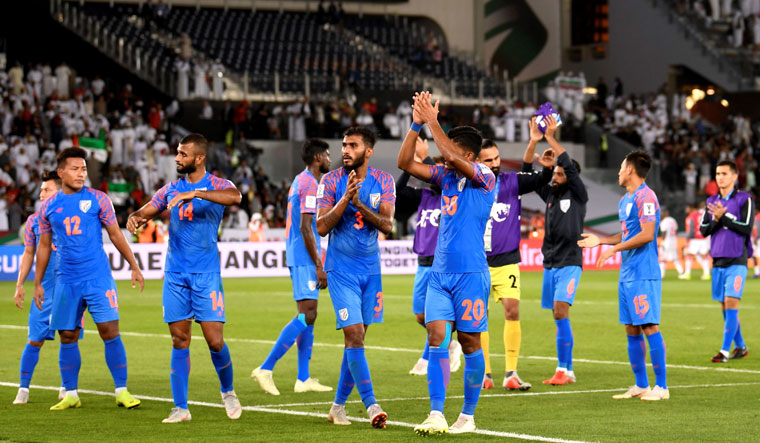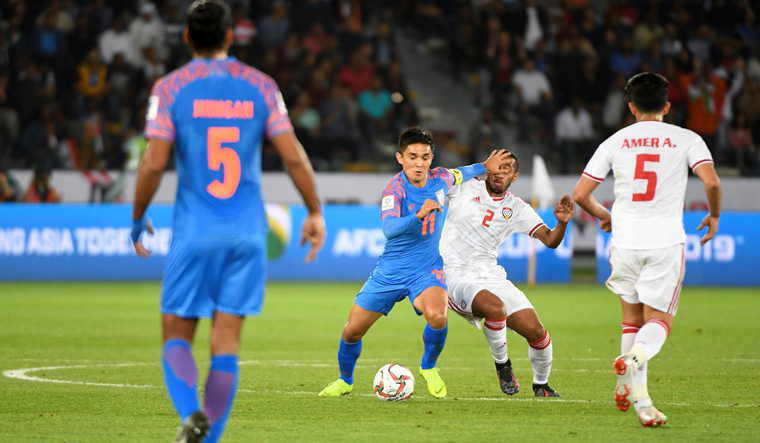Despite the 2-0 loss to host UAE in the AFC Asian Cup, the Indian football team continues to defy expectations. If the opening game was about utilising every half chance to crush Thailand 4-1, this game was about chances squandered and little luck for the Indians.
It was yet another example of the score line not telling the full story. Yes, UAE scored on either side of the half and yes, they had a lion’s share of the possession, but India was clearly the better side for most parts and came agonisingly close on several occasions to putting the game past the Emiratis.
The high-intensity approach of Stephen Constantine’s side had yielded fruit in the first match, and it looked like it would again, in the first 25 minutes against UAE. India looked dangerous on the counter and played to their strength. Not very good at keeping the ball, the side preferred to keep the ball in the opponent’s half as much as possible. India completed only 55 per cent of its attempted passes in the game.
ALSO READ: Why India's first 2019 Asian Cup victory is a big deal
India plays a very strong pressing game, putting pressure on the opponents as much as possible. But such an approach is a double-edged sword, particularly when your defence isn’t the best. India plays rough when they lose the ball and dangerous tackles come flying in. Moreover, they looked sapped towards the end of the match—the last 25 minutes in particular.
UAE’s Ismail Alhammadi caused trouble from the left, while Khalfan Mubarak sneaked past the Indian defence to score the first goal, five minutes from half time. India had managed to keep the dangerous number seven, Ali Mabkhout, quiet for most of the first half. In fact, UAE’s first proper chance came only in the 37th minute, by which time India had already squandered several.
Clear chances for Ashique Kuruniyan and two for Sunil Chhetri were denied by some excellent work by UAE’s keeper Khalid Eisa in the first half. In the second period, it was the woodwork that denied India’s attempts on goal—first a ferocious strike by Udanta Singh and then a headed attempt from Rowlin Borges’ free kick.
India’s defence worked well as a unit in the opening 30 minutes or so. On several occasions, the Emiratis tried long shots as they could not break through the defence. But they soon ditched that approach as the game wore on and the Indian defenders started to look weary.
India looked frantic in tight situations and tried to push the ball ahead as much as they could. But UAE made sure they slowed down the game in the last half an hour. As good as India are on the counter, they cannot contain the same when it comes from the opponent. Both UAE goals were scored against the run of play.
India’s defence is a cause for worry, particularly the centre backs. Lack of coordination and poor marking led to both goals. Meanwhile, goalkeepeer Gurpreet Singh Sandhu was left hoofing the ball in the air every time he got a hold of it, and came close to scoring an own goal when a shot off the post bounced off him.
As for the attackers, Ashique was a long way off from his Thailand performance, while Chhetri was plain unlucky. Udanta looked like a bright spark on the right. His substitution, though, came as a surprise. Jeje Lalpekhlua, who replaced Halicharan Narzary, provided some moments of brilliance, but he, too, fell short.
 Indian football team salutes the crowd after their AFC Asian Cup group match loss to UAE | AFP
Indian football team salutes the crowd after their AFC Asian Cup group match loss to UAE | AFP
The game was a gradual decline for India. From a position of strength, they conceded the first goal. Despite this, they came into the second half strongly, but gradually caved in. UAE showed experience and composure to seal the game.
It served as a reminder for India that it should be playing west Asian sides like these more often, rather than teams ranked below. Ali Mabkhout’s goal to double the score line exposed the chinks in the Indian armour as he collected a long ball and swivelled his way through to finish in style.
Overall, it was a highly entertaining game. That India could hold out so well against an Arab side is a sign of much improvement. There were moments of beautiful link-up play, and the pace with which the team attacks, continues to be its strongest weapon. That could come in handy against a Bahrain side in India’s last group game.
Though Bahrain held UAE to a draw in their first match, against Thailand, bizarre tactics and poor defending did them in, to lose 1-0. Bahrain is usually a more disciplined side, but in the last 10 minutes of the game, the coach threw in all his attackers into the game and there was almost no midfield to link defence with attack. Their defenders look unsteady and slow and India could capitalise on that.
As things stand, India has found itself in one of the more exciting groups of the tournament. UAE is on top with four points, India and Thailand have three, while Bahrain has only one. All four teams stand a chance to progress. India need at least a draw in the last game to seal their berth in the round of 16. And once it reaches the knockout stage, it will need all the luck in the world.



